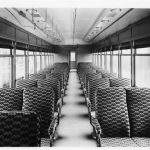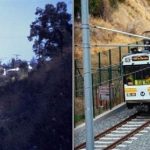Pacific Electric’s Santa Monica Air Line: From Toonerville Trolley to Metro Rail
By Ralph Cantos
Pacific Electric car no. 994 rounds the curve at Overland Avenue in the spring of 1950. This is the westbound afternoon / evening trip. Hollywood cars provided service for the last three years of the line’s existence.
PE’s Santa Monica Air Line was something of an “institution.” The line was built in 1875 by the Los Angeles and Independence Railroad. Just 2 years after the line opened, the LA & I RR decided to sell the line to the Southern Pacific Railroad. The SP, hoping to build up a lucrative freight business, built at its own expense the world famous “LONG WHARF” in hopes of beating out Long Beach and San Pedro as a major shipping port. When that did not work out, the SP leased the line and Wharf to the Los Angeles Pacific Railroad around 1908. A few years later, all LA&P holdings and infrastructure were taken over by the “New PE” in the Great Merger of 1911.
The Santa Monica Air Line was essentially built as a freight line. Passenger service along the line tended to be an annoyance to the PE. Passenger schedules along the line reflected the PE’s annoyance with the line. The best service (what there was) was provided between Downtown LA and Culver Junction. West of Culver Junction, the service was “sparse” at best. After several unsuccessful attempts to abandon passenger service altogether, a “compromise” was reached with the Public Utilities Commission (PUC) around 1932-33: a grand total of ONE in-and-outbound passenger trip was provided for the “convenience” of about 50 die-hard regular passengers who cherished the rail service.
Meanwhile, the world-famous Venice Short Line that provided much more frequent service to essentially the same destinations, was abandoned on September 17, 1950, leaving the Air Line as the lone passenger service on the Westside of LA, Santa Monica, and Venice.
This wonderful passenger service was cut back to 11th Avenue on October 27, 1953, leaving those faithful Air Line passengers high and dry.
This was done in preparation for the sale to Metropolitan Coach Lines of all remaining PE passenger service, both rail and bus. When MCL took over PE’s passenger service, the Air Line was not included in the sale. And so for about 30 days in October of 1953, the Air Line would become the LAST passenger service on the PE.
Today, rail service along the Air Line has been reborn as the LACMTA’s EXPO Line. Two- and three-car air-conditioned trains run along the line at 12 minute intervals with standing-room-only passenger loads, a far cry from the 50 faithful passengers that kept the line going for so many years, riding aboard 800s, 950s, 1000s and finally, Hollywood cars to the bitter end in 1953.
Ralph Cantos Collection







One important fact that is mostly lost on many historic accountings of the LA&I is that it started out life as a 3’6″ narrow gauge railroad. It was standardized by the Southern Pacific after their acquisition. Since it was originally intended to haul ore from mine to port, the civil engineers involved in the planning and design must have been influenced by the railroad building boom in taking place at the same time in Colorado when they settled on building a 3’6″ railroad instead of the standard 4’8.5″ inch which is used today.
With reference to Steve’s comment: I don’t know the original gauge of LA&I, but most US narrow gauge RR’s had a three foot gauge, not 42″. This includes those in Colorado and the Carson & Colo (later the SP narrow gauge). Of course, LARY had a 42″ gauge track.
This 1877 Report of the Board of Commissioners of Transportation to the Legislature of the State of California lists it as a standard gauge railroad along with all of the narrow-gauge rail in California, so it’s pretty clear it was standard gauge in 1877.
But the LA&I opened in 1875 so maybe they changed gauge in the first two years of operations? But who knows? Do you know where it’s listed as narrow gauge?
In George Hilton’s exhaustive tome “American Narrow Gauge Railroads” no mention is made of the Los Angeles & Independence Railroad. In Mullaly and Petty’s “Southern Pacific in Los Angeles” nothing is said about any need to change the gauge of the LA&I upon its acquisition by the SP. In short, the LA&I was standard gauge from day one.
The image of 994 approaching the stop & crossing at Sexton, was taken by Norman Newcomb. I own the negative & copyright to this image. Please make changes to your captioning to reflect these facts.
Just to clarify some more, the long wharf project was an extension of services that had successfully been provided on previous wharfs closer to the Santa Monica Pier area. After being moved up the coast, where an engine turning facility could be located, the wharf expanded to reach deeper water. Santa Monica Bay had long been thought to be a natural harbor point and even Santa Fe once had designs on the area. I believe the Huntington’s owned a lot of the Palisades land, and Collis was planning on retiring to SoCal prior to his untimely demise. If that harbor had stayed put, history would have been very different..they would have had to use Long Beach in the background of all those teeny bopper surfing films!